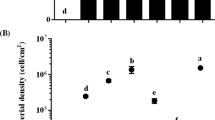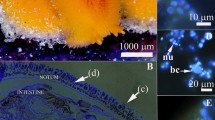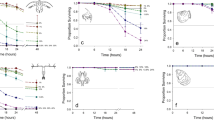Abstract
A GRADIENT of antibacterial activity along fronds of the large brown seaweed Laminaria1 runs opposite to gradients of density of bryozoans and spirorbid tube worms settled on the fronds2,3. Bryozoan colonies attached to a Laminaria frond grow towards the younger region4, where antibiotic production is lowest. It has been suggested that tannins produced by branch tips of Sargassum have an anti-fouling role5, but we have seen no other clear evidence of such an effect, although many marine plants and animals remain remarkably free from encrustation by other organisms6. We have now found further evidence in several examples of differential settlement by spirorbid worms on algae and by a bryozoan on another species of bryozoan.
This is a preview of subscription content, access via your institution
Access options
Subscribe to this journal
Receive 51 print issues and online access
$199.00 per year
only $3.90 per issue
Buy this article
- Purchase on Springer Link
- Instant access to full article PDF
Prices may be subject to local taxes which are calculated during checkout
Similar content being viewed by others
References
Hornsey, I. S. & Hide, D. Br. phycol. J. 11, 175–181 (1976).
Stebbing, A. R. D. J. mar. biol. Ass. U.K. 52, 765–772 (1972).
Knight-Jones, E. W., Knight-Jones, P. & Al-Ogily, S. Proc. ninth Europ. mar. biol. Symp. (ed. by Barnes, H.) 539–561 (Allen & Unwin, London, 1975).
Ryland, J. S. & Stebbing, A. R. D. Proc. fourth Europ. mar. biol. Symp. (ed. Crisp, D. J.) 105–123 (Cambridge University Press, Cambridge, 1971).
Sieburth, J. M. & Conover, J. T. Nature 208, 52–53 (1965).
Burkholder, P. R. Biology and Geology of Coral Reefs 2, Biology 1 (eds Jones, O. A. & Endean, R.) 117–182 (Academic, New York, London, 1973).
Knight-Jones, E. W., Bailey, J. H. & Isaac, M. J. Proc. fourth Europ. mar. biol. Symp. (ed. Crisp, D. J.) 89–104 (Cambridge University Press, Cambridge, 1971).
Hornsey, I. S. & Hide, D. Br. phycol. J. 9, 353–361 (1974).
Stebbing, A. R. D. J. mar. biol. Ass. U. K. 51, 283–300 (1971).
Bate-Smith, E. C. Phytochemical Ecology (ed. Hardorne, J. B.) 45–56 (Academic, London, New York, 1972).
Davies, J. M., Ferrier, N. C. & Johnston, C. S. J. mar. biol. Ass. U.K. 51, 237–246 (1973).
Author information
Authors and Affiliations
Rights and permissions
About this article
Cite this article
AL-OGILY, S., KNIGHT-JONES, E. Anti-fouling role of antibiotics produced by marine algae and bryozoans. Nature 265, 728–729 (1977). https://doi.org/10.1038/265728a0
Received:
Accepted:
Issue Date:
DOI: https://doi.org/10.1038/265728a0
This article is cited by
-
Antifouling Technology Trends in Marine Environmental Protection
Journal of Bionic Engineering (2021)
-
Feeding repellence in Antarctic bryozoans
Naturwissenschaften (2013)
-
Waterborne chemical compounds in tropical macroalgae: positive and negative cues for larval settlement
Marine Biology (1996)
-
Measurement of the carrying capacity of benthic habitats using a metabolic-rate based index
Oecologia (1993)
-
Resource limitation and fish predation: their importance to mobile epifauna associated with JapaneseSargassum
Oecologia (1993)
Comments
By submitting a comment you agree to abide by our Terms and Community Guidelines. If you find something abusive or that does not comply with our terms or guidelines please flag it as inappropriate.



